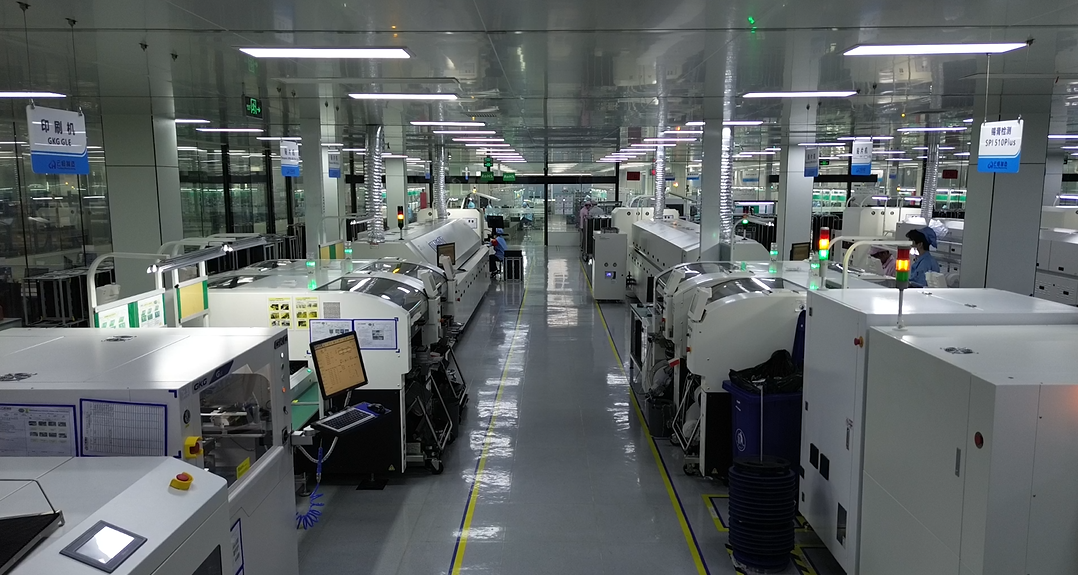InsideanSMTAssemblyFactory:HowYourElectronicsCometoLife
Core Equipment and Technology
SMT (Surface Mount Technology) assembly factories rely on specialized machinery to place miniature electronic components onto printed circuit boards (PCBs). High-speed pick-and-place machines operate with precision, positioning components as small as 0.4mm x 0.2mm at rates exceeding 25,000 placements per hour. Reflow ovens with multiple heating zones create controlled thermal profiles to melt solder paste without damaging sensitive parts. Advanced stencil printers ensure consistent solder paste application, while automated optical inspection (AOI) systems verify placement accuracy down to micron-level tolerances. These technologies combine to handle complex PCB designs for consumer electronics, automotive systems, and industrial equipment.
Production Workflow
The assembly process begins with PCB loading and solder paste application through laser-cut stencils. Conveyor systems transport boards to component placement stations where feeders supply chips, resistors, and capacitors. After component mounting, boards enter reflow ovens where precise temperature curves activate the solder paste's adhesive properties. Secondary processes may include through-hole component insertion, conformal coating application, or box-build assembly. Throughout production, barcode tracking systems monitor each batch, enabling full traceability from raw materials to finished products. Real-time monitoring software alerts technicians to any process deviations, maintaining consistent output quality.
Quality Control Measures
Multiple inspection stages ensure product reliability. Post-reflow AOI scanners compare board images against CAD designs to detect missing components or alignment errors. X-ray inspection systems examine hidden solder joints under ball grid array (BGA) packages. Functional testing rigs simulate actual operating conditions, verifying electrical performance and signal integrity. Statistical process control charts track defect rates, while cross-sectional analysis randomly samples solder joints for microscopic examination. Quality teams maintain ISO 9001 standards, conducting regular audits and implementing corrective actions for continuous improvement. All test data gets archived for customer review and regulatory compliance documentation.

Workforce Expertise
Skilled technicians oversee SMT operations, requiring knowledge of electronics manufacturing and machine programming. Engineers optimize production lines by analyzing cycle times and material flow patterns. Maintenance teams perform preventive equipment calibrations using laser alignment tools and thermal profilers. Operators undergo rigorous training on ESD (electrostatic discharge) protection protocols and cleanroom practices. Cross-functional collaboration between design, procurement, and production teams helps resolve technical challenges during new product introductions. Many factories maintain apprenticeship programs to develop specialists in solder chemistry analysis and thermal management solutions.
Environmental Considerations
Modern SMT facilities implement eco-friendly practices without compromising efficiency. Lead-free solder alloys comply with RoHS directives, while nitrogen-assisted reflow ovens reduce oxidation and improve joint quality. Waste management systems separate metal-bearing sludge from wastewater treatment processes. Energy recovery units capture heat from exhaust systems to preheat incoming fresh air. Component packaging gets recycled through partnerships with material recovery specialists, achieving over 90% non-hazardous waste diversion rates. Some factories utilize solar panels and smart lighting systems to minimize their carbon footprint, aligning with global sustainability initiatives.
Customization Capabilities
Flexible manufacturing systems accommodate diverse customer requirements. Quick-change tooling adapts production lines for prototype batches and mass production runs. Dual-lane conveyors allow simultaneous processing of different board types. Advanced factories offer value-added services including PCB design optimization for manufacturability (DFM) and component sourcing from certified vendors. Specialized teams handle complex assemblies containing mixed technology components, such as combining surface-mount devices with press-fit connectors. For low-volume, high-mix orders, modular work cells with robotic assistance maintain cost-effectiveness while ensuring precision.
Supply Chain Integration
Efficient material management forms the backbone of SMT operations. Automated storage systems track component reels using RFID tags, with inventory levels updated in real-time. Vendor-managed inventory programs synchronize material deliveries with production schedules, minimizing storage costs. Multi-sourcing strategies for critical components prevent supply chain disruptions. Some factories employ just-in-time delivery models, coordinating with local logistics partners to maintain lean stock levels. Digital twin technology simulates material flow scenarios, helping planners optimize warehouse layouts and mitigate potential bottlenecks.
Industry Challenges and Solutions
Component miniaturization drives demand for finer-pitch placement capabilities, addressed through improved machine vision systems and vacuum nozzle designs. Thermal management challenges in high-density assemblies get resolved using advanced solder alloys and convection reflow techniques. Cybersecurity measures protect programmable logic controllers (PLCs) from potential breaches as factories adopt Industry 4.0 connectivity. To address skilled labor shortages, augmented reality (AR) systems guide technicians through complex maintenance procedures. Collaborative robots work alongside human operators for repetitive tasks like feeder loading, enhancing productivity while reducing ergonomic risks.
